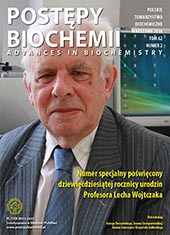Mitofusin 2 and mitochondrial dynamics in norm and pathology
Abstract
Results of an intensive research performed during last 25 years have revealed that an understanding of biochemical and molecular principles of oxidative phosphorylation has not finished the streak of ground-breaking discoveries of newly identified mitochondrial functions in numerous cellular processes. Among other things it has been shown that mitochondria undergo reversible fission and fusion processes, and may form a complex network which functionally and structurally interacts with the endoplasmic reticulum membranes and probably also other organelles. An organization of mitochondrial network is closely controlled and is of high importance for numerous intracellular processes to occur properly. In this review, mitofusin 2 â one of a few proteins involved in a maintenance of an appropriate mitochondrial architecture, and in the consequence in the regulation of mitochondrial metabolism and calcium signalling, the controlling of the mitochondrial DNA level, and the regulation of cell proliferation and differentiation is the focus. Mutations within mitofusin 2-encoding gene are a cause of Charcot-Marie-Tooh 2A â type neuropathies while an affected expression of this protein seems to be related to neoplasia, type 2 diabetes, or vascular hyperplasia. Numerous experimental data confirm pleiotropic effects of mitofisin 2 in animal cells.
Downloads
Published
Issue
Section
License
All journal contents are distributed under the Creative Commons Attribution-ShareAlike 4.0 International (CC BY-SA 4.0) license. Everybody may use the content following terms: Attribution — You must give appropriate credit, provide a link to the license, and indicate if changes were made, ShareAlike — If you remix, transform, or build upon the material, you must distribute your contributions under the same license as the original. There are no additional restrictions — You may not apply legal terms or technological measures that legally restrict others from doing anything the license permits.
Copyright for all published papers © stays with the authors.
Copyright for the journal: © Polish Biochemical Society.




